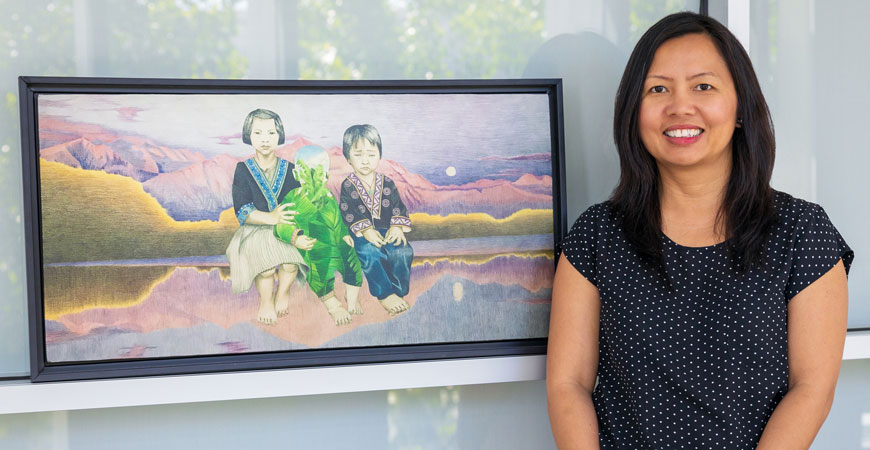
Exploring sources of historical narratives can take you to places where walls seem to move and truth feels fluid and interchangeable. Ma Vang’s research has focused on how people narrate their histories, tracking the lived experiences of people pigeonholed or marginalized by dominant narratives that privilege the record and written text.
These experiences include her own. Vang, a UC Merced critical race and ethnic studies professor and founding chair of the university’s CRES program, was born in Thailand as a refugee from war violence. She and her family lived in a camp for Hmong people driven from Laos by the so-called “secret war” between government and Pathet Lao forces, backed heavily by Cold War superpowers. Hmong soldiers were used in military operations run by the U.S. CIA.
Before, during and after the deadly conflicts that radiated from the war in Vietnam, Hmong found themselves abandoned by the United States and persecuted by the new Communist regime. Military violence that took as prisoner Vang’s grandfather, a village leader, forced Vang’s family to flee their home south of the Mekong River, settling eventually in the Thailand camp.
“I have some memories of it, moments here and there,” Vang said of the refugee camp, “But they’re not complete memories. I can recall some of the celebrations, my friends. But if you were to ask me what day-to-day life was, I could not give a full picture.”
After many years in the refugee camp, Vang joined the Hmong diaspora that had resettled in the United States. She and her family settled in the northern California city of Oroville. Vang was 9 years old.
Decades later, the lived experiences of Hmong and other peoples would play a large part in her scholarly research. A major result of that work is a book: “History on the Run: Secrecy, Fugitivity and Hmong Refugee Epistemologies.” Published in 2021, the book analyzes the often-obscured narratives of Hmong people, particularly during the Vietnam War era. It dives into epistemology — the study of where knowledge comes from and how it forms … and who does the forming.
In my work, stories play a dominant role because they help orient us within the world. They help develop a sort of identity. But stories are based on lived experience. They carry history within them.
“History on the Run” centers people Hmong as vital sources of knowledge. Vang challenges and critiques the typical archival methods and historical narratives that tend to brush aside or erase experiences of marginalized groups.
“In my work, stories play a dominant role because they help orient us within the world. They help develop a sort of identity,” Vang said. “But stories are based on lived experience. They carry history within them.”
The concept of history on the run is an elusive and dynamic form of knowledge not easily contained in traditional archives. Instead, it is tied tightly to refugees’ movements and experiences. This framework allows Vang to explore how histories and knowledge are carried physically and metaphorically by displaced people rather than existing only in official documents.
The book hits on several points, including:
Such gaps and representations make their way into curriculums and classrooms. Vang recalled being taught about Vietnam in middle school. “It wasn’t about the Vietnamese. It was more about the American veterans, about the United States perspective on the war,” Vang said.
It made her question if stories she heard growing up in the Thai camp and in her Hmong community in California were true.
“I think this happens to a lot of students of color,” Vang said. “We have to do the extra work of learning the master narrative but untangling it from the histories of our families and communities.”
Opening minds and realigning knowledge are at the heart of critical race and ethnic studies, an interdisciplinary field that seeks to understand how society is culturally and institutionally formed by ideas of race, ethnicity, gender, sexuality, class and nation. It requires absorbing and questioning ideas inside and outside the classroom, Vang said.
“With coming to consciousness,” Vang said, “you have to go out there and work and talk and learn about the issues and figure out your place in them.”